Indoor air quality if not monitored and maintained properly can lead to severe health impacts. Furthermore, the worsened air climate negatively affects the productivity and cognitive function of employees. Amidst the Covid-19 pandemics, many venues such as restaurants and hotels struggle to keep visitors and shoppers. In this comprehensive guide, you will find information on the main indoor air pollutants, how to cope with them and why you should do it now.
What are the main factors affecting indoor air quality?
The indoor environment in buildings is a result of factors such as the site, climate, building system and construction techniques, contaminant sources, and the activities performed inside the buildings. And before we focus on how to improve air quality, we need to discuss what the main pollutants are. It is essential to understand the role that each of these factors plays to prevent and cope with indoor air quality problems.
Sources of indoor air contaminants
Indoor air contaminants can originate within the building or come in from outdoors. If contaminant sources are not managed properly, indoor air quality problems can arise, even if the HVAC system is well-maintained. And so, what are the main triggers to worsen air quality?
- Sources outside the building – pollen, dust, fungal spores, industrial pollutants, general vehicle exhaust, exhaust from the building itself or neighboring buildings, soil gas, or standing water promoting excess microbial growth;
- Equipment – the HVAC system can affect indoor air quality when there is dust or dirt in ductwork, or when there is microbiological growth inside, or from improper usage of biocides, and/ or cleaning compounds, or there is a refrigerant leakage;
- Maintenance activities – airborne dust or dirt, volatile organic compounds (VOCs) from use of paint, caulk, adhesives, and other products, pesticides from pest control activities, or emissions from stored supplies;
- Building Furnishings – microbiological growth in water-damaged furnishings, emissions from new furniture installation, dust and fibers from demolition, odors from paint, caulk, adhesives, micro biologicals released from remodeling activities;
HVAC system design and operation
The HVAC system includes all heating, cooling, and ventilation equipment inside a building. A properly designed and functioning HVAC system provides thermal comfort, distributes adequate amounts of outdoor air to meet the ventilation needs of all building occupants, isolates and removes odors and contaminants through pressure control, filtration, and exhaust fans.
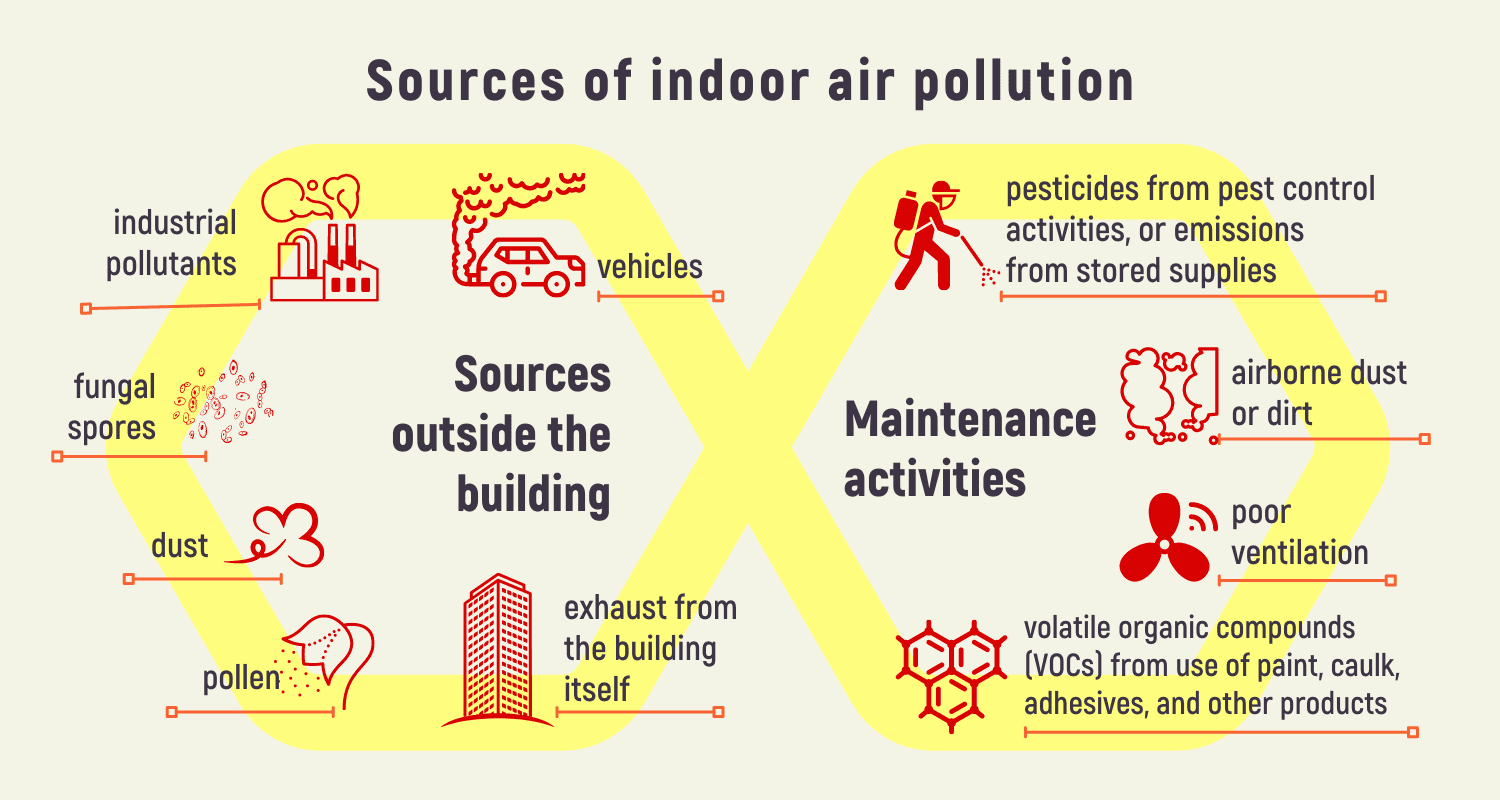
Uniformity of temperature is critical to provide thermal comfort in a building.
It is important to cope with factors such as discomfort due to radiant heat gains and losses, and humidity. Increasing relative humidity reduces the ability to lose heat through perspiration and evaporation so that the effect is identical to raising the temperature. However, humidity extremes can also create indoor air quality problems. Excessively high humidity can produce discomfort and it can promote the growth of mold and mildew.
Air pollutant pathways and driving forces
Airflow inside buildings results from the combined action of ventilation systems, human activity, and natural forces. Pressure gaps created by these forces move airborne contaminants from areas of relatively higher pressure to areas of relatively lower pressure through any available openings.
The basic principle of air movement can produce many patterns of contaminant distribution, including:
- Local circulation in the room containing the pollutant source;
- Air movement into spaces that are under lower pressure;
- Recirculation of air within the building part containing the pollutant source
- Movement from lower to upper levels of the building
- Airflow through outdoor air or reentry of exhaust air
Why indoor air quality monitoring is important?
Monitoring air quality is important to keep building occupants healthy and satisfied.
A good rating of indoor air quality also means more productivity for your employees. Last but not least, amidst the Covid-19 pandemics, governments across the world are urging for reliable measures towards air quality in buildings.
Air quality and health impacts
Indoor air quality greatly affects the health and comfort of building occupants. Understanding and managing common pollutants indoors can help reduce the risks related to air quality health concerns. Generally, the effects of indoor air pollutants may be categorized into two main groups based on how they arise.
Immediate health impacts
Some health effects may show up shortly after a single or repeated exposure to a pollutant occurs. These include irritation of the eyes, nose, and throat, headaches, dizziness, and fatigue. These immediate effects are often short-term and easily cured. Sometimes the solution is simply eliminating the source of the pollution if it can be identified. Unfortunately, exposure to some indoor air pollutants aggravates or worsens diseases such as asthma.
The immediate reactions to indoor air pollutants depend on factors such as age or any other chronic medical conditions.
In some cases, whether a person reacts to a pollutant depends on individual sensitivity, which varies greatly from person to person. Some people can become very much sensitive to biological or chemical pollutants after constant or elevated exposure.
An effort should be made to identify indoor air quality sources that impact health negatively. Some of the triggers may be an inadequate supply of outdoor air coming indoors or from the heating, cooling, or humidity conditions prevalent indoors.
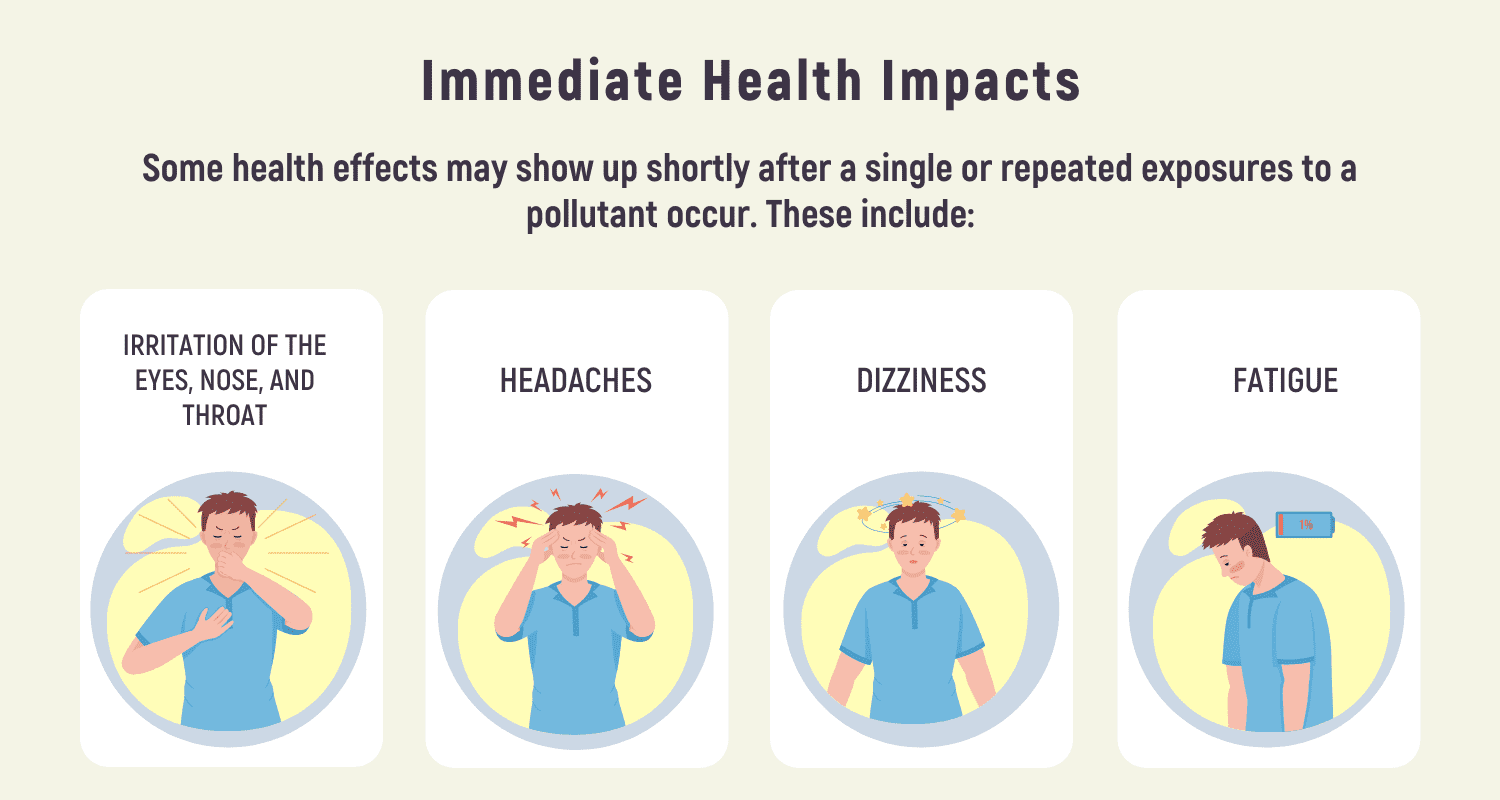
Air quality and long-term health impacts
Other health impacts may show up years after exposure has occurred in case of repeated periods of exposure. Such health impacts may be some respiratory diseases, heart disease, and even cancer. It is crucial to understand the health hazard of bad air quality and so try to improve the indoor air quality in your building even if symptoms are not yet noticeable.
Air quality and productivity in the office
Just two months ago, the Harvard School of Public Health released a paper on how air quality may affect employees’ cognition and productivity. According to the School, the air quality inside an office can have serious impacts on employees’ cognitive function and their ability to focus. Thus it may also affect employees’ productivity.
The one-year study, which included participants in offices six countries working in fields such as engineering, investment, architecture, and technology, found that high concentrations of fine particulate matter (PM2.5) and lower ventilation rates (measured using carbon dioxide (CO2) levels as a rate) were associated with slower response times and reduced accuracy on a series of cognitive tests. It turns out that the researchers observed weakened cognitive function at concentrations of PM2.5 and CO2 that are very common for the built environment.
Furthermore, taking into account two other studies, Harvard Business Review found that better air quality leads to significantly improved decision-making among participants. Researchers saw better test results when workers were exposed to increased ventilation rates, lower levels of chemicals, and lower carbon dioxide.
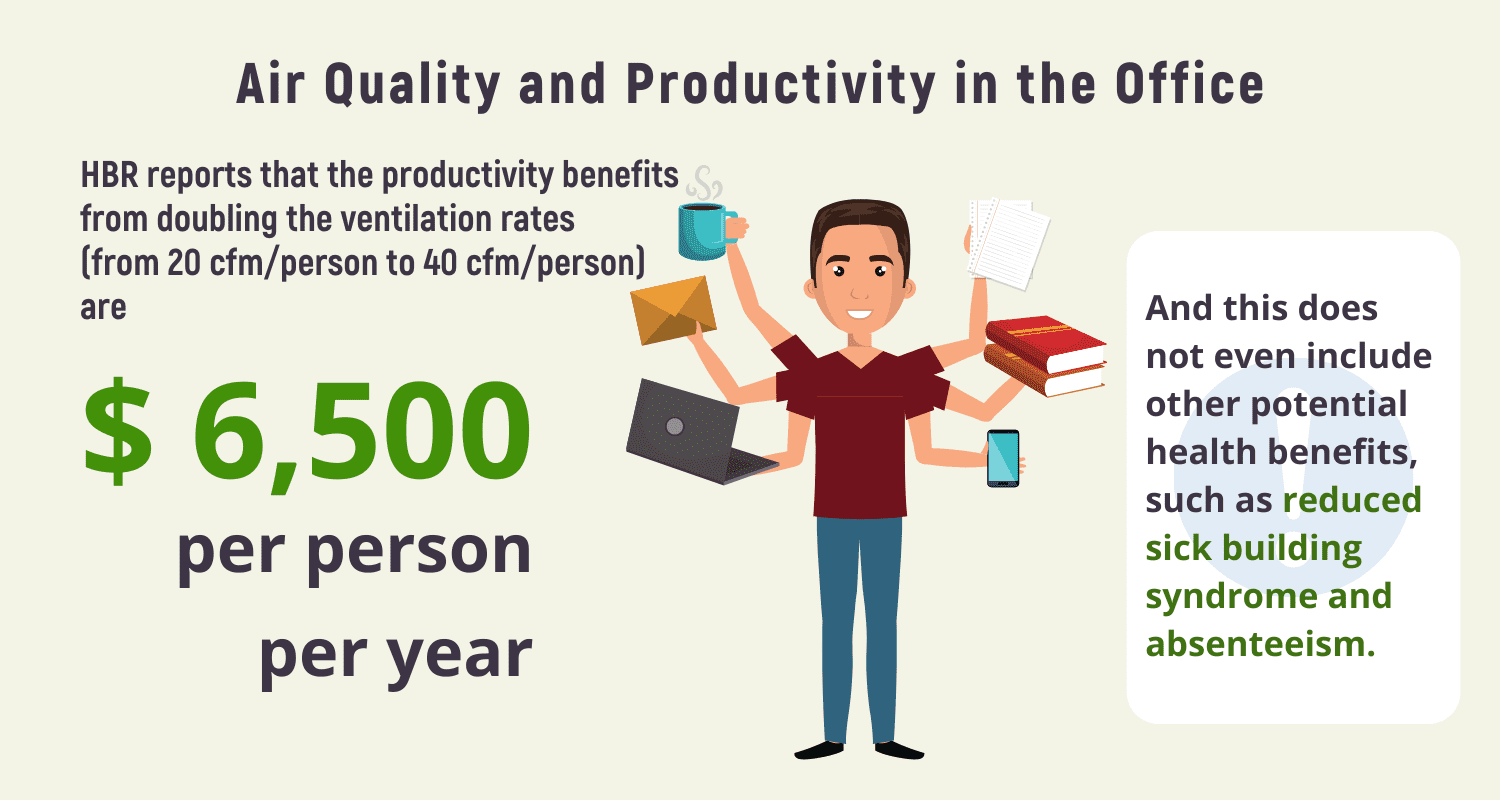
In conclusion, HBR reports that the productivity benefits from doubling the ventilation rates (from 20 cfm/person to 40 cfm/person) are $6,500 per person per year. And this does not even include other potential health benefits, such as reduced sick building syndrome and absenteeism. Ultimately, facility managers should take into account that the costs for improving air quality can be properly weighed against the health and productivity benefits. An enhanced facilities budget will reduce human resource costs, which makes buildings an important human resource tool.
Air Quality and the new Covid-19 measures
Indoor air quality monitoring is more and more becoming a part of government advisory or even legislation frameworks all over the world.
The United Kingdom government made air quality trackers mandatory and allocated some £25 million in public money to install such monitoring systems to all state-funded education settings. Тhe new air quality monitors will enable school staff to act immediately where ventilation is not performing to the needed standards and make sure that existing ventilation measures are working properly.
The Belgium COVID-19 Commissariat also published two official documents to regulate the quality of indoor air. As the virus is spread through aerosols, ventilation plays a key role in reducing the risk of infection. Proper ventilation allows for the improvement of indoor air and reduces the presence of COVID-19 contaminated aerosols. According to Belgium authority, the CO2 content of the air should, ideally, not exceed 900 ppm, and under no circumstances should it exceed 1200 ppm. Currently, Belgium’s Corona Commissioner Pedro Facon has made CO2 meters and real-time monitoring compulsory for all hotels, restaurants, bars, banquet halls, and fitness centers.
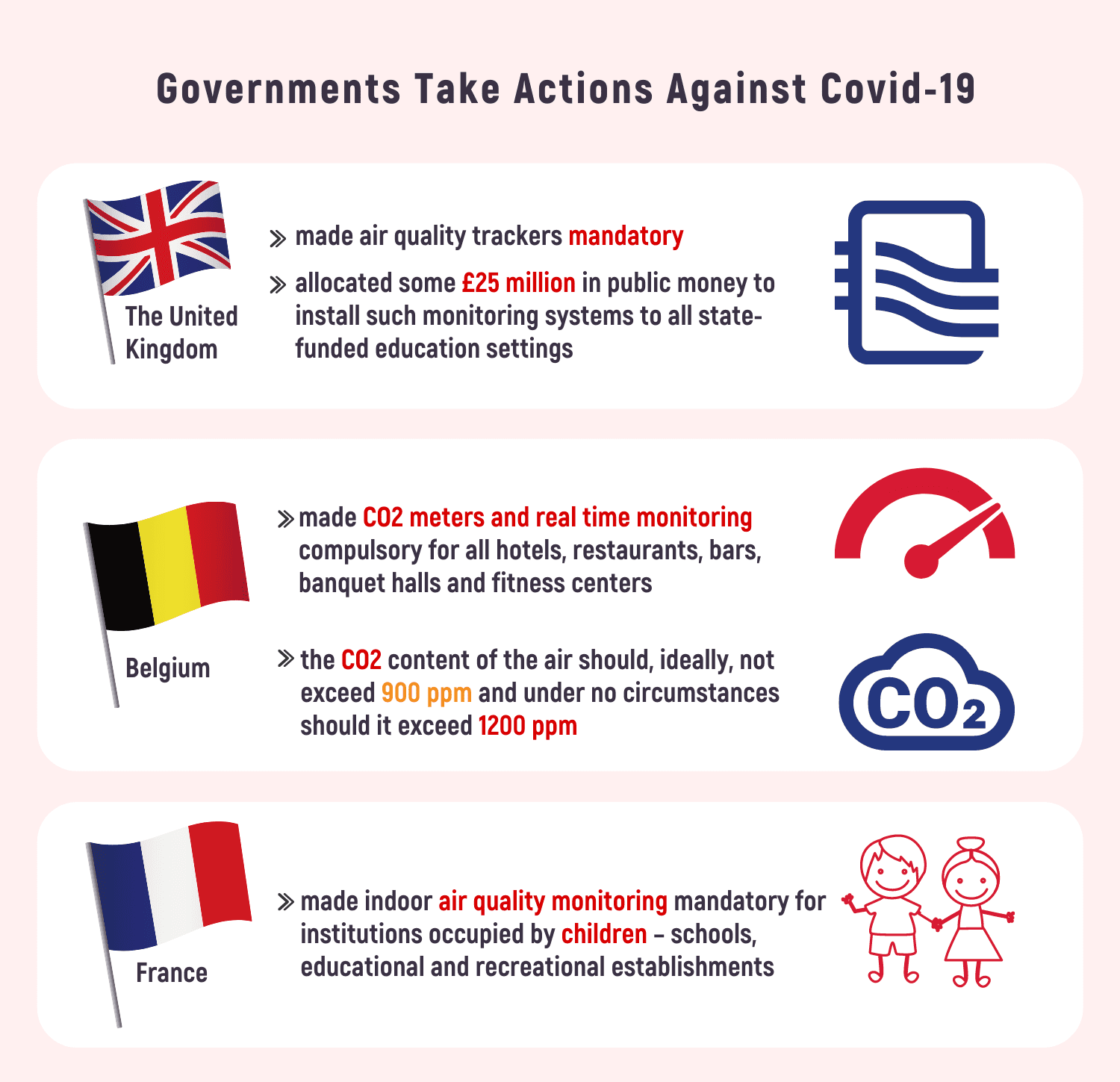
The French National Environmental Commitment Act also made indoor air quality monitoring mandatory for institutions occupied by children – schools, educational and recreational establishments. In schools, children are exposed to different pollutants emitted by furniture, cleaning products, and school supplies. The concentrations of air pollutants in schools can sometimes be higher than in other places because of occupancy density and poor ventilation.
The National Environment Agency in Singapore provides building owners and facilities managers with measures to enhance the air quality in indoor spaces, through improving air-conditioning and mechanical ventilation. According to the Agency, facility managers may use CO2 trackers to identify under-ventilated areas or overcrowding, so that immediate actions can be taken to improve the situation. Reporting should be made over at least 5 minutes per location, especially in occupied areas at breathing zones. Concerning the current COVID-19 situation, building owners are advised to aim for CO2 levels below 800 ppm.
The Australian Building Codes Board recommends levels of 850 ppm on average for 8 hours. The Board’s handbook has more like an advisory role at the moment.
The Netherlands has launched the Specific Benefit Ventilation In Schools (SUVIS) scheme that supports municipalities to improve the indoor climate of existing school buildings. This aid will cover construction and installation costs and amounts to 30% of the renovation costs, with a maximum based on the number of students.
How to improve indoor air quality
Having a strategy in place to ensure proper ventilation and filtration inside buildings is critical for providing healthy indoor air to visitors and employees. To reduce pollutants in the air and prevent the spread of viruses such as Cоvid-19, it is important to improve ventilation rates to the reasonable and recommended extent. You should also consider improving filter efficiency and using additional air cleaners.
Increase Ventilation Rate
- Conduct an HVAC assessment to evaluate its condition, including all related systems.
- Inspect your HVAC systems often to allow for repair or replacement of equipment as soon as needed.
- Service your ventilation system to ensure it performs as designed.
Adjust the HVAC system to bring in more outdoor air. - Note: When HVAC adjustments are not possible, use other means of increasing outdoor air – open windows, use window fans, in case weather and outdoor air quality allows.
Increase HVAC Filter Efficiency
- Increase filter efficiency in existing HVAC systems by using filters with the highest Minimum Efficiency Reporting Value (MERV) rating possible (per equipment specifications). If possible, increase the level of the air filter to MERV 13 or higher.
- Make sure the filters are installed and replaced according to the manufacturer’s instructions.
Incorporate Portable Air Cleaners
- Consider using portable air cleaners to additionally improve air quality.
- Make sure air cleaners suffice the requirements of your space
- Use only air cleaners that meet government regulations and industry standards for ozone generation.
- Airflow to and from air cleaners should not be obstructed.
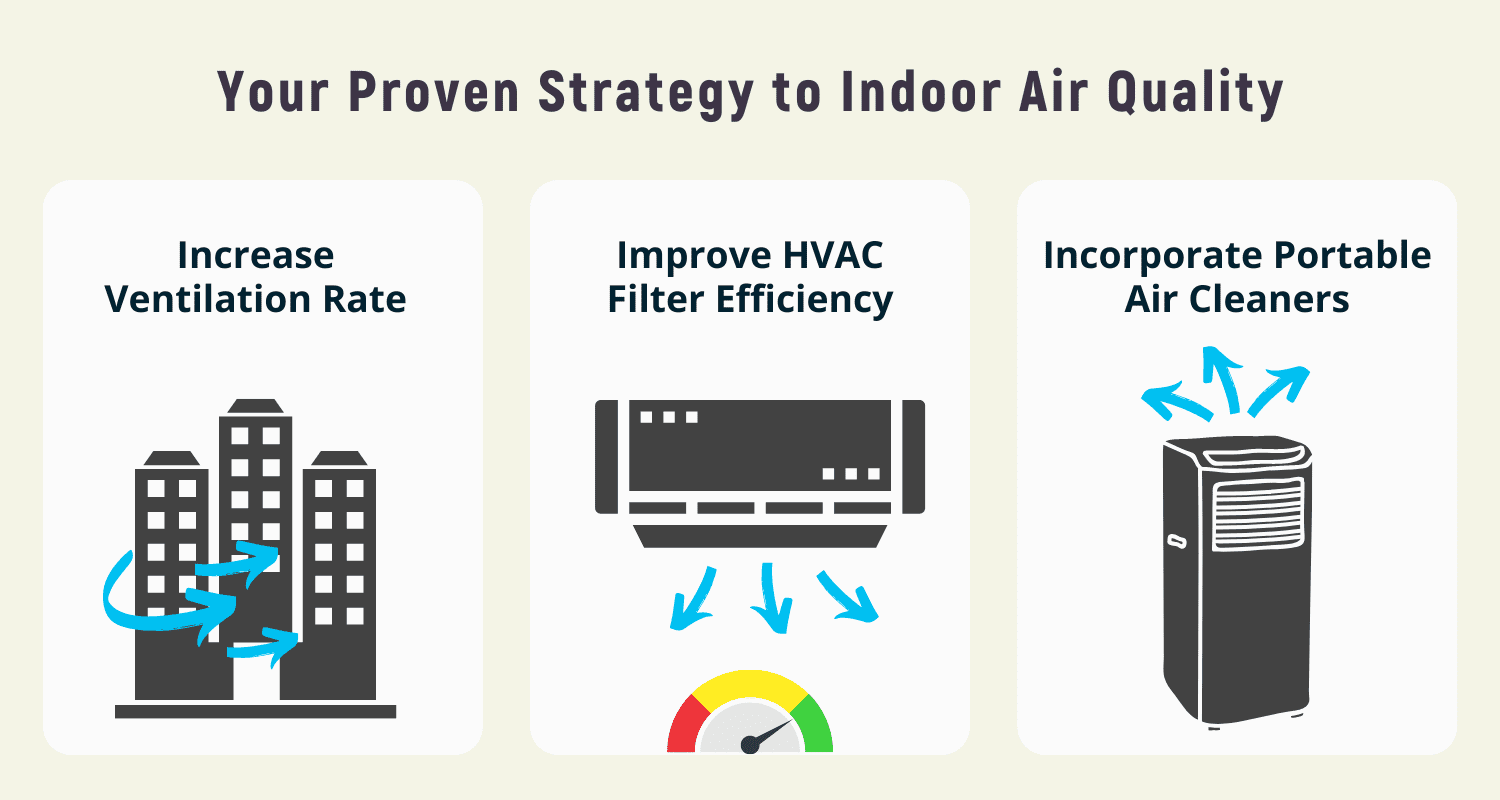
What is a good air quality rating?
Poor air quality is a result of various particulate matter (PM) in the air. PM consists of a complex mixture of solid and liquid particles of organic and organic substances which have been suspended in the air.
Typical particulates found in the air include:
- Coarse particles, often 10 microns (μm) or bigger (1µm = 1/1,000th of a millimeter). Examples include visible coarse dust, sand, leaves, hairs, and other large organic particles.
- PM10 – airborne particles =/< 10µm in diameter including coarser fine dust and organic particles.
- PM2.5 – airborne particles =/< 2.5µm in diameters such as pollen, spores, and other organic particles.
- PM1 – airborne particles =/< 1µm in diameter, including dust, combustion particles such as diesel fumes, bacteria, and viruses.
Tracking these particles, chemicals, and gasses is an important first step in achieving good indoor air quality. Here are some of the acceptable ratings to have in mind:
- Particulate Matter (PM2.5): 0 – 12 ug/m3
- Particulate Matter (PM10): 0 – 54 ug/ m3
- Volatile Organic Compounds (VOCs): 0 – 15 ppm
- Carbon Dioxide (CO2): 400 – 650 ppm
- Formaldehyde: 0 – 0.1 ppm
- Carbon Monoxide (CO): 25 ppm limit for an 8-hour workday
- Nitrogen Dioxide (NO2): 100 ppb 1-hour standard


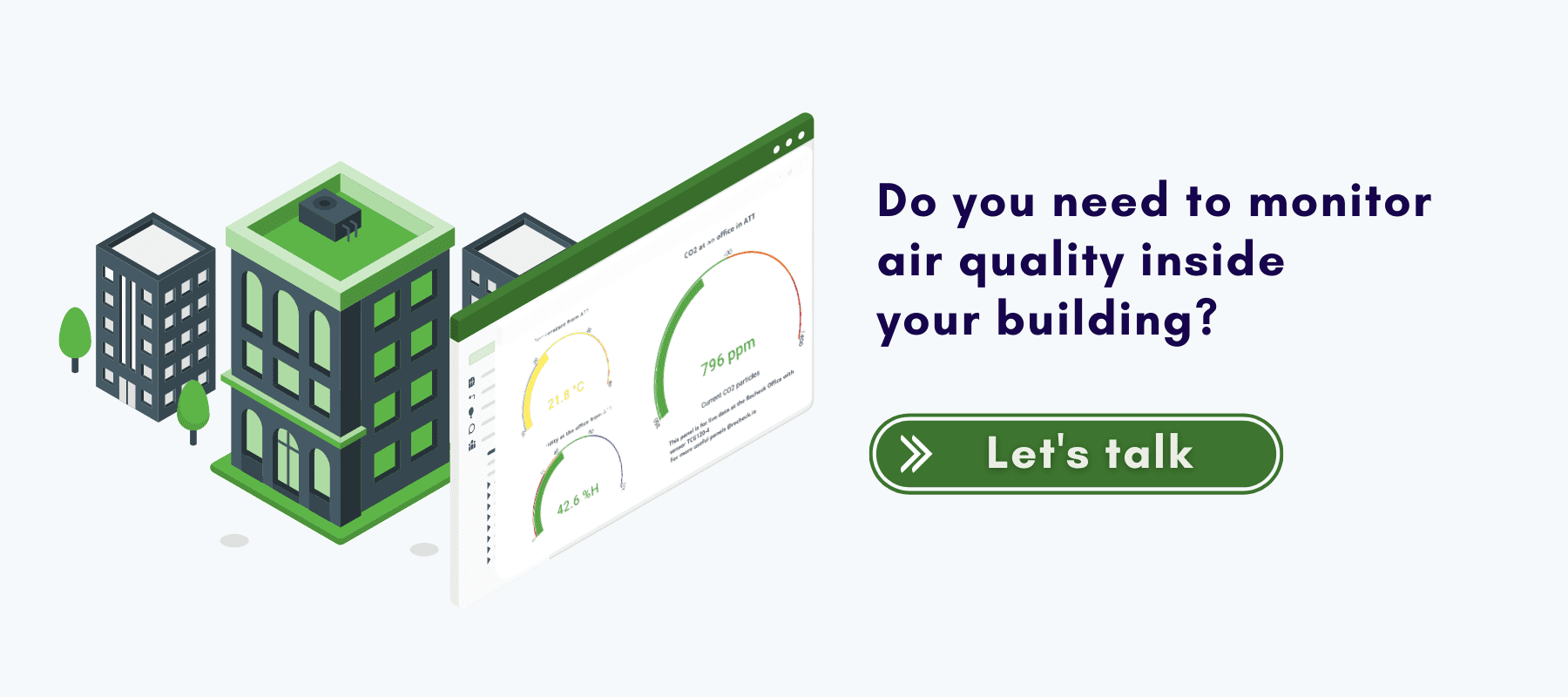
![CO2 Meters For Schools - the Ultimate Guide [Infographics] CO2 Meters For Schools - the Ultimate Guide [Infographics]](https://recheck.io/blog/wp-content/uploads/2022/01/CO2-Meters-For-Schools-300x160.png)


